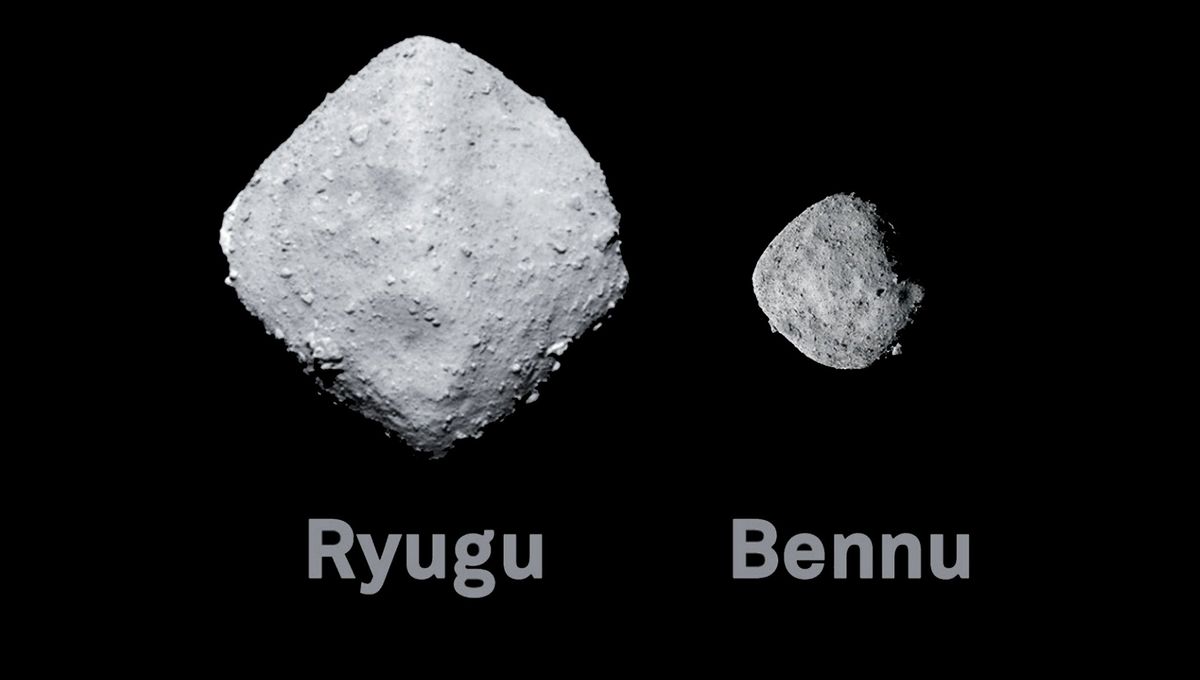
Humanity has collected samples from three asteroids: the stony type, Itokawa, and the carbonaceous Ryugu and Bennu. Carbonaceous asteroids are the largest class, so it wouldn’t be too surprising that both Ryugu and Bennu are among them; still, their similarities might be a lot deeper than previously thought. New research puts forward a bold hypothesis: Bennu and Ryugu are siblings.
In the asteroid belt, there is a world called Polana. Today, it has a diameter of 55 kilometers (34 miles), but it was much larger in the past. Collisions broke it apart, and some of its fragments became asteroids in the main belt, now described as the Polana family. There might be others too, and some of them could have been sent inwards towards Earth’s orbit. This is the possible origin of Bennu and Ryugu.
We are pretty certain that Polana and the Polana family members were once a single body. The question is whether or not Bennu and Ryugu are as well.
Dr Anicia Arredondo
By using JWST, researchers obtained the highest-quality light spectrum from Polana in the near-infrared; this was compared to the spectrum of the Bennu and Ryugu samples, brought to Earth respectively by OSIRIS-REx and Hayabusa2. The similarities found between them add to previous evidence linking these bodies together.
“The JWST observations tell us that Polana is made up of materials that we expect to see on carbonaceous asteroids, as opposed to what we would expect on siliceous or metal-rich asteroids. These similar materials were found on Bennu and Ryugu, which suggests that they all have similar compositions,” lead author Dr Anicia Arredondo, from the Southwest Research Institute, told IFLScience.
“We are pretty certain that Polana and the Polana family members were once a single body. The question is whether or not Bennu and Ryugu are as well. The similarities in the spectra of the three bodies don’t rule out that Polana, Ryugu, and Bennu were once a single body. A way we could be more certain is if we sent a spacecraft mission to Polana and brought back a sample to Earth, like we did with Bennu and Ryugu,” Arredondo added.
Understanding the origin of Bennu and Ryugu would give us important insights into the early Solar System. Both asteroids are rich in organic compounds, some of which are precursors to molecules fundamental to life. Both were changed by water, once they were in a much larger planetary body. Recent research shows that Bennu has a very heterogeneous composition, with bits coming from the inner and outer Solar System, as well as interstellar material.
The diversity of components, as well as some differences found in the spectra, are important to keep in mind, but they are not a major challenge to the idea that these objects were all part of a single body. The Polana family, Ryugu, and Bennu could have all started the same, but the depth of origin in the parent body, collisional history, weathering, and other post-formation processes might have given each object its own unique characteristics. More work is needed to find out what happened.
“I am going to observe more Polana family members that are smaller than Polana. I want to know what their compositions can tell us about the original body and the collision that broke them apart,” Arredondo told IFLScience.
The precious samples of asteroid material are changing what we know of asteroids and the early Solar System. And it is clearly just the beginning of what they will deliver.
“This is the vision of sample return missions like OSIRIS-REx and Hayabusa2 brought to life: connecting laboratory analyses of pristine extraterrestrial materials not just to specific near-Earth asteroids, but all the way back to their source regions in the asteroid belt,” Professor Dante Lauretta, Principal Investigator of OSIRIS-REx, who was not involved in the study, told IFLScience.
“With JWST, we now have a direct spectral window into that source. The ability to tie returned samples to telescopic observations of their parent body represents a milestone in our effort to understand the formation and evolution of planetary building blocks.”
The study is published in The Planetary Science Journal.
Source Link: Asteroids Bennu And Ryugu Could Be Siblings – And We Might Have Found Their Parent